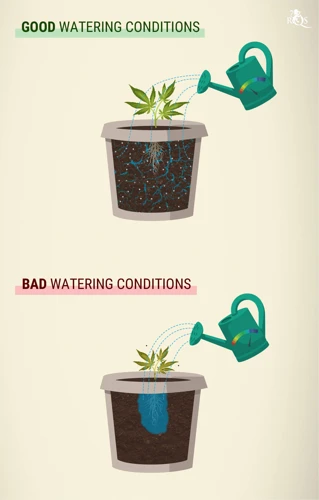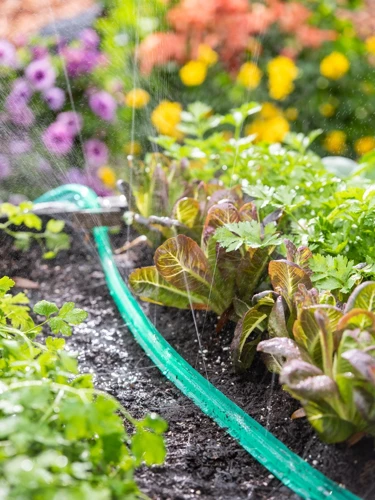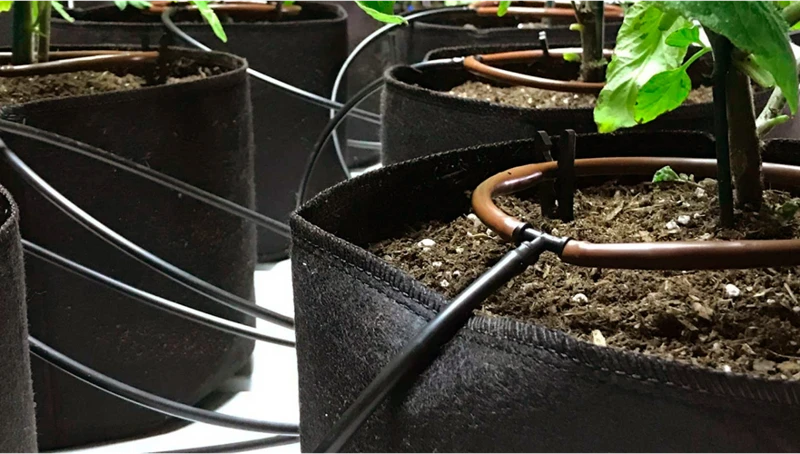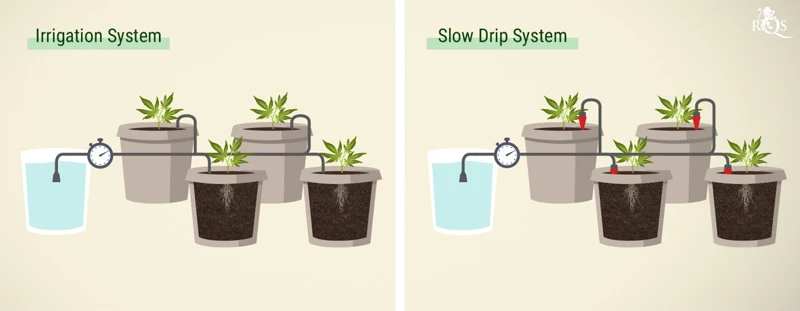
5 Effective Watering Methods for Cannabis Plants
Growing cannabis plants requires proper care and attention, and watering plays a crucial role in achieving healthy growth and a bountiful harvest. However, with so many watering methods available, it can be overwhelming to decide which one to choose. Each watering method comes with its own set of advantages and disadvantages, and selecting the right one depends on several factors, such as the environment, type of soil, and available resources. In this article, we will explore the top five watering methods for cannabis plants, their advantages, and disadvantages, to help you make an informed decision and achieve optimal growth for your plants.
1. Hand Watering
Contents
Watering your cannabis plants is essential for their growth and survival. One of the most common methods of watering is through hand watering, which involves using a watering can or hose to water your plants. This method can be both effective and convenient, but it also has its drawbacks. Let’s explore the advantages and disadvantages of hand watering your cannabis plants.
Advantages of Hand Watering
Hand watering is a traditional method of watering cannabis plants that involves using a watering can, hose or any other container to water the plants. There are several advantages to using hand watering as a method of providing water to cannabis plants. Some of these advantages include:
| Advantages of Hand Watering |
| * Precise Control |
| Hand watering allows for precise control over the amount of water each plant receives. This level of control allows growers to adjust the water supply to each plant based on its individual needs which is important during the different stages of growth. |
| * Adjusting watering times based on plant needs |
| During the different stages of growth, cannabis plants require different amounts of water. With hand watering, growers can adjust the watering times and frequency based on the specific needs of each plant. This ensures that the plants receive the appropriate amount of water and ultimately promotes healthy growth. |
| * Monitoring plant health |
| Hand watering allows growers to get up close and personal with their plants. By watering each plant individually, it’s easier to spot any issues like discoloration or under/overwatering, which can be addressed promptly. Prompt attention to individual plant issues can promote healthy growth and prevent further issues that can lead to a decrease in yield and quality. |
| * Easy to implement |
| Hand watering is a simple method that requires minimal equipment and setup. As such, it is one of the easiest watering methods to implement, making it a go-to for beginner growers or those who have a small number of plants. |
Hand watering is a reliable and effective method of watering cannabis plants that offers high precision and control while promoting healthy growth.
Disadvantages of Hand Watering
While hand watering can be an effective method for watering cannabis plants, it does have its drawbacks. Here are some of the disadvantages of hand watering:
| Disadvantages |
| 1. Inconsistent watering: Depending on the person doing the watering, it can be difficult to ensure that each plant is getting the same amount of water each time. This can lead to over or under watering, which can impact the overall health of the plants. |
| 2. Time consuming: Hand watering each individual plant can be a time consuming process, especially if you have a large grow operation. This may not be a feasible option for those with a lot of plants to care for. |
| 3. Risk of nutrient burn: When watering by hand, there is a risk of accidentally spilling nutrient-rich water on the leaves or stems of the plants. This can lead to nutrient burn, which can harm or even kill the plant. |
| 4. Risk of pests and disease: Watering by hand can also increase the risk of pests and disease. When water is applied directly to the leaves and stems of the plant, it creates an ideal environment for pests and disease to thrive. |
While hand watering can be effective for small operations, it may not be the best option for larger grows. It is important to consider all options and choose the method that works best for your specific situation.
2. Soaker Hoses
When it comes to watering your cannabis plants, you want to make sure you have a method that provides consistent moisture without wasting water. One option to consider is the use of soaker hoses. These are specially designed hoses that slowly release water directly into the soil, minimizing evaporation and ensuring that the roots of your plants receive the necessary moisture. But like with any watering method, there are both advantages and disadvantages to using soaker hoses for your cannabis plants.
Advantages of Soaker Hoses
Soaker hoses are a great option for watering cannabis plants. They have several advantages over other watering methods:
- Efficient use of water: Soaker hoses deliver water directly to the soil around the plants roots, reducing water evaporation and runoff. This makes them very efficient in their water usage and can save water in the long run.
- Even distribution of water: Soaker hoses deliver water evenly and consistently along the entire length of the hose, ensuring that every plant gets the optimal amount of water it needs.
- Prevent overwatering: Soaker hoses allow water to be released slowly, preventing overwatering and waterlogging of the soil, which can be detrimental to plant growth.
- Easy to use: Soaker hoses are easy to install and use. Simply attach the hose to a water source, lay it down in the garden bed, and cover it with soil or mulch. They can also be set up with a timer to automate watering.
- Reduced risk of disease: Because soaker hoses deliver water directly to the soil, water does not come into contact with the plant foliage. This minimizes the risk of disease caused by excess moisture on plant leaves and stems.
Soaker hoses are a great choice for watering cannabis plants, as they are efficient, easy to use, and promote healthy plant growth.
Disadvantages of Soaker Hoses
Although soaker hoses have many advantages when it comes to watering cannabis plants, there are several disadvantages that should be taken into consideration before using this method. These include:
| Disadvantages of Soaker Hoses | |
| 1. Slow watering: | Soaker hoses can be slow when it comes to watering your cannabis plants. This means that it may take longer for your plants to receive the water they need, which could hinder their growth. |
| 2. Uneven distribution: | Soaker hoses distribute water unevenly, meaning that some areas of your plants’ root systems may receive less water than others. This can cause your plants to grow unevenly and could also lead to nutrient deficiencies. |
| 3. Clogging: | Soaker hoses can become easily clogged with dirt or other debris, which can prevent water from reaching your plants. This can lead to under watering and could cause your plants to wilt or die. |
| 4. Limited control: | Soaker hoses offer limited control over the amount of water your plants receive. This could be problematic if your plants require different amounts of water as they grow, or if you need to adjust the watering schedule due to weather conditions. |
| 5. Moisture retention: | Soaker hoses can retain moisture in the soil for longer periods of time, which can create a favorable environment for mildew, mold, or other plant diseases to develop. |
While soaker hoses are generally an effective way to water cannabis plants, these disadvantages should be taken into account to ensure that you are providing your plants with the right amount of water, at the right time, and in the right way.
3. Drip Irrigation
When it comes to watering cannabis plants, there are a variety of methods that growers can choose from. One popular option is drip irrigation, which involves slowly and steadily supplying water directly to the roots of the plants. This method is efficient and can help conserve water, but it also requires careful monitoring and maintenance to ensure that the plants receive the proper amount of moisture. Let’s take a closer look at the advantages and disadvantages of using drip irrigation for your cannabis garden.
Advantages of Drip Irrigation
Drip irrigation has several advantages when it comes to watering cannabis plants. Here are some of the most important ones:
- Precise Watering: Drip irrigation systems allow for precise delivery of water and nutrients directly to the roots of each plant, which helps to avoid over or under watering. This ensures that the plants receive the exact amount of water they need, resulting in healthier plants and maximum yield.
- Conserves Water: Drip irrigation systems conserve water by delivering water directly to the plants and reducing evaporation. This is particularly important in areas where water is scarce or subject to restrictions.
- Reduces Plant Diseases: By delivering water directly to the roots of plants, drip irrigation systems also reduce the risk of fungal diseases caused by wet leaves or standing water around the base of the plants. This is particularly important in humid and wet climates.
- Easy to Install and Maintain: Drip irrigation systems are relatively easy to install and maintain. They require less work than other watering methods, such as hand watering or using soaker hoses.
- Saves Time and Effort: Drip irrigation systems save time and effort by automatically delivering the water and nutrients directly to the plants. This reduces the amount of time and effort needed to water the plants manually.
Drip irrigation is a highly efficient and effective method for watering cannabis plants, and it offers many benefits over other watering methods.
Disadvantages of Drip Irrigation
Drip irrigation is an effective way to water cannabis plants, but like any other method, it has its drawbacks. Here are some of the key disadvantages to consider:
| Disadvantages | Explanation |
| High initial cost | Setting up a drip irrigation system can be expensive compared to other watering methods, particularly if you have a large grow space. The cost of materials, such as tubing, emitters, and a timer can add up. |
| Potential for clogging | If your water source has a high level of mineral content or sediment, your drip emitters can become clogged and water won’t flow through them properly. This can lead to uneven watering or dry spots. |
| Requires maintenance | You will need to regularly inspect and clean your drip irrigation system to ensure that it is functioning properly, particularly if you have hard water or a large system. This can be time-consuming and requires some technical knowledge. |
| Not suitable for all growing setups | Drip irrigation may not be the best choice for small grow spaces, as the tubing can take up significant room and can be difficult to maneuver around. Additionally, drip emitters need to be set up at the right height to work properly, which can be a challenge in certain setups. |
While drip irrigation can be a highly effective way to water your cannabis plants, these disadvantages should be carefully considered before deciding if this method is right for you. If you have a large grow space and are willing to invest the time and money into setting up and maintaining a drip irrigation system, it can be a great choice. However, for smaller grow spaces or those with limited resources, a simpler watering method like hand watering or bottom feeding may be a better option.
4. Watering from the Bottom
When it comes to watering cannabis plants, there are several methods available, each with its own set of advantages and disadvantages. One such method is bottom watering, which involves watering the plants from the bottom up. This technique can be particularly useful for maintaining consistent moisture levels in the soil and is often recommended for young or newly transplanted plants. However, like any watering method, there are certain considerations to keep in mind when using this technique. Let’s dive deeper into the advantages and disadvantages of bottom watering for cannabis plants.
Advantages of Bottom Watering
Bottom watering is a popular watering method among cannabis cultivators, and it comes with certain advantages. Some of the main advantages of bottom watering include:
- Efficiency: Watering from the bottom allows the plants to take up water at their own pace, preventing any water from being wasted due to runoff or evaporation.
- Prevention of Overwatering: Overwatering is a common problem faced by growers, and it can lead to root rot and other issues. Bottom watering prevents overwatering by allowing the soil to gradually absorb water without drowning the roots.
- Healthy Root Development: When plants are bottom-watered, the roots are encouraged to grow downward in search of moisture. This can lead to stronger and healthier root systems, which can result in better plant growth and yields.
- Less Mess: Bottom watering can be a tidy solution for growers who don’t want to deal with the mess of spilled water or soil splashing onto foliage during watering.
Bottom watering is a simple and effective watering method that can promote healthy plant growth while saving water and preventing overwatering.
Disadvantages of Bottom Watering
Bottom watering, while it has its advantages, also has some notable disadvantages to consider. Here are some potential drawbacks to keep in mind:
- Root Bound Plants: Bottom watering can lead to plants becoming root bound, as the roots may only seek out water at the bottom of the container instead of spreading out throughout the soil. This can stunt the growth of the plant and negatively impact its overall health.
- Increased Risk of Algae and Fungus: When watering from the bottom, it’s possible for stagnant water to accumulate in the tray or saucer. This can create a moist environment that promotes the growth of harmful fungi or algae, which can be detrimental to the plant’s health.
- Inefficient Watering: Depending on the size and shape of the container, bottom watering may not effectively reach all areas of the soil. This can lead to some parts of the soil becoming too dry or too wet, which can cause stress to the plant.
- Difficult to Monitor: Unlike other watering methods, it can be harder to tell when plants have received enough water when using bottom watering. This can make it difficult to monitor plants and ensure they are getting the appropriate amount of water.
- May Attract Pests: Standing water in trays or saucers can also attract pests, such as mosquitoes or gnats, which can be a nuisance both for the plant and for the person caring for it.
Considering these potential drawbacks, it’s important to carefully weigh the advantages and disadvantages of bottom watering before implementing this method in your cannabis growing routine.
5. Top Feeding
When it comes to watering cannabis plants, there’s no one-size-fits-all approach. One method that some growers prefer is top feeding, which involves adding water directly to the top of the soil. This method can help ensure that the plants get the nutrients they need, but it also comes with a few downsides. Let’s dive into the advantages and disadvantages of top feeding your cannabis plants.
Advantages of Top Feeding
Top feeding is a watering method that involves applying water directly to the soil surface surrounding the cannabis plant. This method is advantageous for several reasons, including:
- Efficiency: Top feeding allows for water to directly reach the roots of the plant without being wasted by evaporating or being absorbed by foliage.
- Avoiding Foliage Damage: Watering from above can lead to water droplets sitting on leaves for long periods of time, which can cause mold or other issues. Top feeding eliminates this risk.
- Flexibility: Top feeding provides flexibility in terms of how much water is applied to each plant, allowing for more precise watering based on individual plant needs.
- Root Access: This method allows for access to the roots of the plant and ensures they receive the necessary amount of water and nutrients they need to grow and thrive.
Top feeding provides a reliable and efficient way to water cannabis plants without the risk of foliage damage or water waste. By targeting the roots directly, top feeding ensures that each plant is getting the water and nutrients it needs to grow healthy and strong.
Disadvantages of Top Feeding
Top feeding, despite its advantages, can also have some disadvantages. One of the main disadvantages of top feeding is the risk of overwatering the plants. Overwatering leads to waterlogging of the soil, which can cause root rot and other diseases. Additionally, the nutrients may not properly reach the roots and instead accumulate on the surface, leading to nutrient burn.
Another disadvantage of top feeding is the possibility of underfeeding the plant. If the water and nutrients are not properly distributed, some areas of the soil may not receive sufficient nutrients, resulting in stunted growth or nutrient deficiencies. This makes it crucial to carefully monitor the amount and frequency of watering when using this method.
Top feeding may require more frequent watering as the water evaporates quickly due to the exposed surface area of the soil. This can be time-consuming and may require multiple watering sessions throughout the day.
Finally, top feeding can also be messy, especially if not done properly. If water is poured too quickly or with too much force, it can cause soil to spill out of the container or onto the leaves, leading to soil erosion and possibly damaging the plants.
The table below highlights the disadvantages of top feeding:
| Disadvantages of Top Feeding |
|---|
| Risk of overwatering |
| Possibility of underfeeding |
| May require more frequent watering |
| Messy if not done properly |
Conclusion
In conclusion, properly watering cannabis plants is crucial for their growth and health. Depending on personal preference and growing environment, different watering methods can be used.
Hand watering allows for precise control over the amount of water each plant receives, but can be time-consuming and labor-intensive.
Soaker hoses provide efficient and even watering for larger grow spaces, but may lead to over-saturation of the soil if not monitored closely.
Drip irrigation is a more automated option that delivers small amounts of water directly to the plant roots, but may require additional equipment and maintenance.
Watering from the bottom allows plants to absorb water as needed, but can also lead to the build-up of salts and mineral deposits in the soil.
Top feeding is a convenient method for delivering nutrients alongside water, but may result in uneven distribution and potential nutrient burn.
Ultimately, it’s important to consider factors such as plant size, soil type, and environmental conditions when choosing a watering method. With proper attention and care, any of these methods can lead to a successful cannabis grow.
Frequently Asked Questions
How often should I water my cannabis plants?
It is recommended to water your cannabis plants when the top inch of soil feels dry. Depending on environmental conditions, this can range from every day to every few days.
Can overwatering harm my cannabis plants?
Yes, overwatering can lead to root rot and other issues that can harm the health and growth of your cannabis plants.
Is it better to water my cannabis plants from the top or the bottom?
Both methods have their advantages and disadvantages, but it is generally recommended to water from the top to ensure even distribution of water and nutrients.
What type of water is best for cannabis plants?
Filtered, pH-balanced water is ideal for watering cannabis plants. Avoid using tap water that contains high levels of chemicals or minerals.
How much water should I give my cannabis plants?
The amount of water will vary depending on the size and stage of growth of your cannabis plants, as well as environmental conditions. As a general rule, water until you see runoff from the bottom of the container, but do not let the plant sit in standing water.
Can I use nutrient-rich water to water my cannabis plants?
While nutrient-rich water can benefit cannabis plants, it is important to monitor their intake to prevent overfeeding or nutrient burn.
What is the best time of day to water my cannabis plants?
It is generally recommended to water cannabis plants in the morning, as this allows excess moisture to evaporate throughout the day and helps prevent issues such as mold and mildew.
Is it okay to water my cannabis plants with cold water?
No, it is not recommended to water cannabis plants with cold water straight from the tap. Allow the water to warm to room temperature before using.
How can I tell if my cannabis plants need more water?
One of the most common signs of dehydration in cannabis plants is drooping leaves that perk up after watering. Additionally, the top inch of soil should feel dry to the touch.
What should I do if I accidentally overwater my cannabis plants?
If you accidentally overwater your cannabis plants, remove any standing water and allow the soil to dry out before watering again. You may also want to consider adjusting your watering schedule or method to prevent future overwatering.






